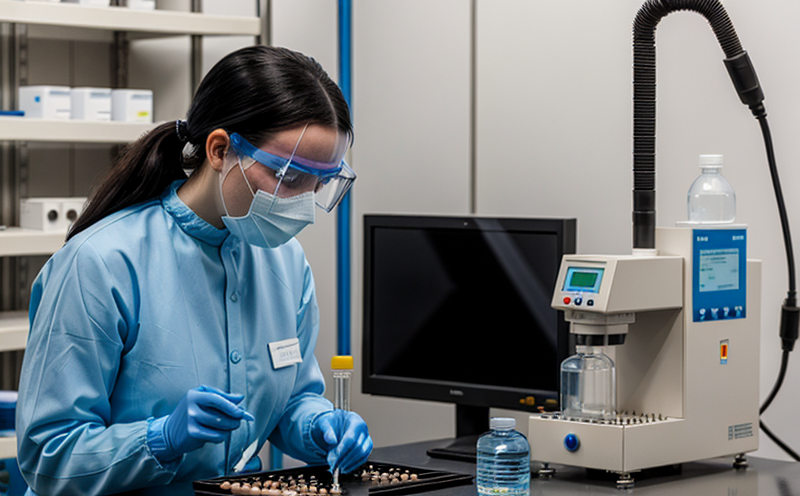Mass Balance Testing of Drug Substances
The process of mass balance testing is a critical component in pharmaceutical development, ensuring that the drug substance (DS) undergoes accurate and reproducible transformations during manufacturing processes. This service involves quantifying all reagents, reactants, intermediates, by-products, and losses to account for every atom of the starting material through each step of synthesis or purification until final product formation.
The significance of mass balance testing lies in its role as a key tool for compliance with regulatory requirements and quality assurance standards. It helps identify any deviations from expected yields, which can indicate potential issues in process control or equipment integrity. For instance, if the yield is significantly lower than anticipated, it could point towards impurities or unreacted starting materials that need to be addressed.
For R&D engineers, mass balance testing ensures that their processes are efficient and meet desired specifications. By accurately measuring each stage of production, they can optimize conditions for better outcomes. Similarly, quality managers rely on these tests to verify batch consistency and adherence to Good Manufacturing Practices (GMP). Compliance officers find value in this service because it supports audit readiness by providing detailed documentation.
When performing mass balance testing, several steps are involved: sample preparation, analysis using appropriate analytical techniques such as HPLC or GC-MS, data interpretation, and reporting. Each step requires precision to ensure accurate results. Sample preparation typically includes dissolution of solids in solvents followed by filtration to remove any particulates.
Instrumentation used for this purpose varies depending on the nature of the drug substance but commonly includes high-performance liquid chromatography (HPLC), gas chromatography-mass spectrometry (GC-MS), and nuclear magnetic resonance spectroscopy (NMR). These instruments provide detailed information about the composition of the samples at each stage.
The goal is to achieve 100% recovery of the starting material in the final product. Any deviation from this indicates that some part of the process may have led to loss or transformation of atoms, necessitating further investigation into the cause and corrective action if required.
Regulatory bodies like the FDA, EMA, and others mandate mass balance testing as part of their review processes for new drug applications. This practice not only enhances product safety but also contributes to public health by ensuring that all medications are manufactured according to strict scientific principles.
- International Acceptance: Mass balance testing is universally recognized across major pharmaceutical markets including North America, Europe, and Asia-Pacific regions. It aligns with international standards such as ICH Q5C for impurity profiling which emphasizes the importance of mass balance calculations in drug development.
Understanding these nuances helps stakeholders appreciate why this service is essential for maintaining high-quality standards within the pharmaceutical industry.
Why It Matters
Mass balance testing plays a pivotal role in ensuring product integrity and regulatory compliance throughout various stages of drug development. Its importance cannot be overstated, as it directly impacts the reliability and safety of pharmaceutical products.
- Ensures Quality: By meticulously tracking all components involved in manufacturing processes, mass balance tests help maintain consistent quality across batches. This is crucial for meeting stringent regulatory requirements imposed by agencies such as the FDA and EMA.
- Identifies Issues Early: Anomalies detected during mass balance testing allow manufacturers to pinpoint potential problems early on, allowing them to implement corrective measures promptly without affecting subsequent batches.
- Safeguards Patient Welfare: Accurate mass balances contribute significantly to patient safety by ensuring that the correct amount of active ingredients is present in each dosage form. Any discrepancy could lead to ineffective treatments or even adverse reactions.
- Aids Regulatory Compliance: Adherence to international standards like ICH Q5C ensures smooth interactions with regulatory authorities during drug approvals, thereby expediting market entry timelines for new medications.
In summary, mass balance testing is indispensable in safeguarding both the integrity of pharmaceutical products and public health. Its meticulous approach towards quantifying every aspect of manufacturing processes underscores its significance within modern-day healthcare practices.
Applied Standards
The implementation of mass balance testing adheres to stringent international guidelines set forth by organizations such as the International Council for Harmonisation (ICH). Specifically, ICH Q5C provides comprehensive guidance on impurity profiling, which includes detailed protocols for conducting mass balances. These standards ensure that all tests are conducted uniformly across different laboratories worldwide.
Other relevant standards include ISO 17025 for laboratory accreditation and GMP guidelines from regulatory bodies like the FDA and EMA. Adherence to these regulations not only enhances credibility but also facilitates smoother collaboration between various stakeholders involved in drug development.
For instance, when performing mass balance tests on a novel compound, compliance with ICH Q5C ensures that all impurities are accounted for accurately. This approach promotes transparency and accuracy, which are vital factors when dealing with complex chemical entities.
In addition to regulatory compliance, adherence to these standards also fosters trust among end-users and stakeholders. By demonstrating rigorous quality control measures during drug development, manufacturers can build stronger relationships with healthcare providers and patients alike.





